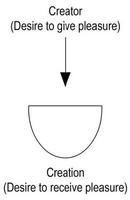The Spiritual Vessel (Kli)
By Avi Ventura
In this section, we will see how Kabbalists use one of the most important aids in their explanations of the Upper Worlds—drawings. Drawings have been part of Kabbalah books for many generations, but Kabbalists never really explained what they were writing about. They simply drew schematics, but they did not explain what they represented.
Kabbalah tells us that all of reality is created from only one force—desire. Kabbalistic drawings, therefore, depict desires and how they “communicate” with one another. While these circles, arrows, and lines may seem dry and scientific, they are actually a code through which a Kabbalist understands a universe of emotions and can then communicate it to other Kabbalists.
The most basic shape you will find in our drawings is that of a Kli, a vessel (drawing 1).
A Kli, in Hebrew, can actually mean two things: a vessel that receives something, and a tool, like a working tool. When we use the word Kli in this section, it will always mean a vessel.
A Kli is drawn like a cup or a bowl, facing up to receive Light from above (drawing 2).
Kabbalah explains that there are only two elements in the whole of creation—the Creator and creation.
The Creator is a desire to give pleasure, usually drawn as a downward arrow. Creation is a desire to receive the pleasure that the Creator wants to give. This is why it is usually drawn as an upwardly bowl or a cup. That desire to receive pleasure is the Kli (drawing 3).
In most cases, you will see arrows pointing to and from the Kli. These represent the way the Kli relates to the pleasure that the Creator wants to give.
A downward arrow, for example, can represent the Creator’s Light (pleasure), which the Kli receives (drawing 3). It can also represent that Kli’s desire to receive the Light. But in any case, the center is always the Kli, because the Kli is actually us, and how we work (if we learn how) with the Creator’s Light.


